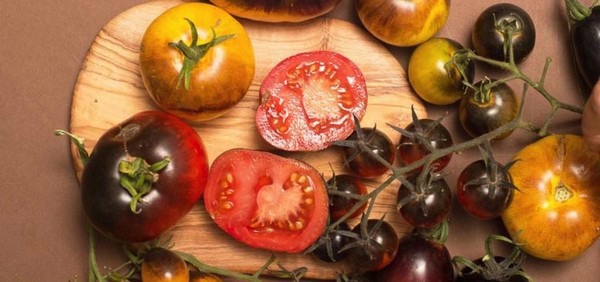In 2011 Jim Myers did something no one had done before. The Oregon State University vegetable breeder released the first purple tomato containing the same healthy compound found in blueberries.
The Indigo Rose tomato, which took Myers, a professor in the OSU College of Agricultural Sciences, and his team 10 years to develop, took the market and other breeders by storm. People liked the tomato’s novelty, but the benefits from the anthocyanins in the skin were the draw. Interest in anthocyanins, the pigment that turns the tomato fruit purple and contains healthy antioxidants, was peaking with the public.

In the last 11 years, Myers has continued to improve his line and has added four other purple tomatoes to the mix: Indigo Cherry Drops, a cherry tomato with better flavor and yield than Indigo Rose; Indigo Pear Drops, a sweet, pear-shaped fruit; and Indigo Kiwi, with improved growth habit, flavor and resistance to leaf curl. The latest is Midnight Roma, a paste tomato being used by chefs and home cooks for sauce that was released in 2021. All are available as seeds sold online and should be started indoors right about now in western Oregon. Some starts will be available at garden centers at the appropriate time for planting in May, maybe June this year (soil temperature should be 60-70 degrees F). But to get the varieties you want, seeds might be the better bet.
Now, there are 50 progenies from Indigo Rose, five from OSU, and the rest from private breeders using Myers’s germplasm, which are the cells that transfer characteristics from generation to generation. Gardeners were already familiar with purple heirloom tomatoes like Cherokee Purple, Black Krim and Black Prince, but the purple hue in those tomatoes is caused by pheophytin, a pigment that doesn’t contain anthocyanins.
Myers and his students painstakingly crossed – often by hand from male stamen to female style – plants that showed potential to express the purple gene in their offspring. Year after year, he and his team selected the best of the best grown in the field for observation and crossed those until he got a purple tomato good enough to release to breeders and home gardeners.
Myers, who has been with OSU for 26 years and is responsible for breeding a green bean variety used by processors on 80% of the acreage in Oregon, made the cross that led to Indigo Rose from the genetic material of wild tomatoes housed at the University of California, Davis, in their germplasm collection. The wild stock was collected by two breeders in the 1960s in Chile and the Galapagos Islands.
The breeders crossed the wild tomatoes with cultivated varieties, but the research didn’t move forward until Myers began his work in the early 2000s when graduate student Carl Jones was looking at how tomatoes affect human health. As Jones studied the germplasm of the wild species from U.C. Davis, he noticed a purple-ish color that had never been characterized, according to Myers.
Work started in earnest to breed a tomato that combined the health benefits of anthocyanins with the characteristics of a good home-grown tomato, they hoped with some disease distance. Once an edible tomato with some purple was produced, the work turned to field evaluations. For 11 years, Myers and his team planted tomatoes and watched them grow and produce. Every year, they took the tomatoes with the best purple expression and crossed them. They did that hundreds of times, choosing the most-promising tomatoes. None of the tomatoes was produced using genetically modified genes.
“Our big discovery was asking the question, ‘What would happen if we cross the sources of purple fruit that originated from different wild species?’” Myers said. “We made selections in the field and chose tomatoes with the most intense expression, which were more resistant to decay and verticillium wilt and will last longer in the field than normal tomato fruit. We found it.”
You’ll begin to see the latest purple variety, a genetically modified tomato from Europe that was approved last year by the U.S. Department of Agriculture. That differs from Myers’ tomatoes, which were bred traditionally, and selected one by one over many years. The new purple tomato, unnamed as yet, will be released in the U.S. market this year but won’t be sold in Europe, where GMO products are illegal.
Source: oregonstate.edu
